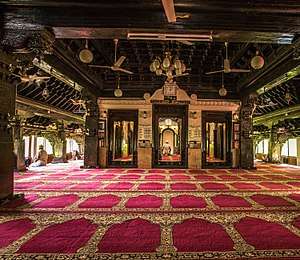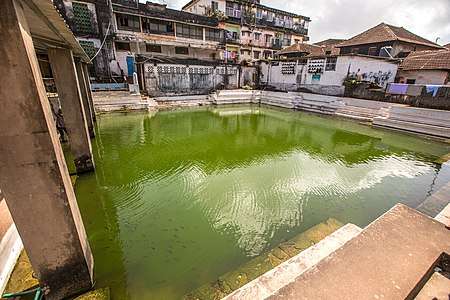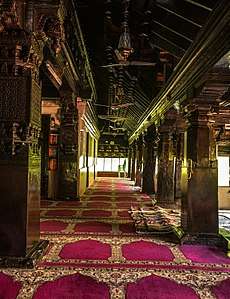Masjid Zeenath Baksh
The Zeenath Baksh Juma Masjid (Kannada: ಝೀನತ್ ಬಕ್ಷ್ ಝುಮಾ ಮಸೀದಿ, 'Mosque that reflects beauty') commonly known as Masjid Zeenath Baksh(Kannada: ಮಸ್ಜಿದ್ ಝೀನತ್ ಬಕ್ಷ್) is the 3rd oldest mosque in India and the oldest in the state of Karnataka.
| Masjid Zeenath Baksh ಮಸ್ಜಿದ್ ಝೀನತ್ ಬಕ್ಷ್ | |
|---|---|
Baliye Palli | |
 Prayer hall of Zeenath Baksh Jama Masjid | |
| Religion | |
| Affiliation | Islam |
| District | Dakshina Kannada |
| Location | |
| Location | Bunder, Mangalore, Karnataka, India |
| State | Karnataka |
| Country | |
 Shown within Karnataka  Masjid Zeenath Baksh (India) | |
| Geographic coordinates | 12.864849°N 74.832187°E |
| Architecture | |
| Style | Dravidian architecture |
| Founder | Malik Deenar |
| Date established | 644 AD |
The mosque was established by the kin and kith of sahabah of prophet Muhammad, thus emerging as of exceptional importance to the Muslims in the region.[1]
History
Arab traders have had a warm longstanding relationship with the local population as well as the rulers of the western coastal belt of India from the earliest of the times, and have engaged in trade through the Arabian Sea.[1]

Consequent on the advent of Islam in the early stage, a team of Arab Muslim Traders, under the Leadership of Islamic propagator Hazarath Mohammed Malik Bin Deenar had visited Malabar and landed at Kodungallur. The then ruler, Raja Cheruman Permal being very appeased with the extremely pious, honest, disciplinary behavior of Malik Deenar and his companions made sure that the traders were provided proper accommodation, necessary facilities, and also a place to trade. The king also went on to provide them with land to build mosques on their request.[2][3]
Masjid Zeenath Baksh was the second out of the ten mosques built by them following Cheraman Juma Mosque of Kodungallur . The masjid was inaugurated on Friday the 22nd of the month of jumadil avval, hijra 22 (644A.D).[4]
In the later half of the 18th century, Tipu Sultan, the sultan of Mysore undertook the renovation process of the mosque.[5] The mosque was not only renovated but also beautified with exquisite wooden carving. These rare pieces of artwork adorn the pillars and ceiling of the mosque.[6][1] It was also during this time that the mosque was renamed "Zeenath Baksh Jama Masjid" from "Malik Dinar Valya Juma-ath Masjid" by Tipu sultan after his daughter.[1]
Features
Although a mosque, Zeenath Baksh has characteristics similar to that of the many temples found in the region, most notably the temple tank similar to those in traditional Hindu temples is found within the proximity of the mosque.[5]
Zeenath Baksh is the only mosque in the state of Karnataka made entirely of wood. The main highlight of the mosque is the wooden inner sanctum consisting of 16 pillars made of teak. The structure is adorned with patterns of symbols, bells, and flowers. It also has life stories of prophet Mohammad inscribed in it. This wooden structure is made up of teak and rosewood which has been used to construct the floor, ceiling, walls and the doors.[6][1]
Gallery
 The water tank within the mosque premises
The water tank within the mosque premises The exquisite wood carvings in the pillars of the mosque
The exquisite wood carvings in the pillars of the mosque
See also
- Cheraman Juma Mosque of Kodungallur
- Tipu Sultan
- Malik Deenar
- Jama Masjid
References
- "Zeenath Baksh Masjid | Zeenath Baksh Masjid Mangalore | Zeenath Baksh Masjid History". Karnataka.com. 2 December 2017. Retrieved 30 June 2018.
- "Zeenath Baksh Masjid, Indian Masjid Zeenath Baksh, Karnataka Masjid Zeenath Baksh, Masjid Zeenath Baksh travel guide, The Zeenath Baksh Masjid of Mangalore". www.kamalkapoor.com. Retrieved 20 May 2018.
- "Masjid Zeenath Baksh (Jumma Masjid), Mangalore - tourmet". tourmet. 6 January 2015. Retrieved 20 May 2018.
- Mangalore, Mangalore Today. "Historic Masjids of Mangalore". www.mangaloretoday.com. Retrieved 30 June 2018.
- "Zeenath Baksh Mosque, Zeenath Baksh Juma Masjid Mangalore". www.mangaluruonline.in. Retrieved 20 May 2018.
- Correspondent, Staff (23 April 2014). "Etched in wood, Masjid is an oasis of peace". The Hindu. ISSN 0971-751X. Retrieved 20 May 2018.